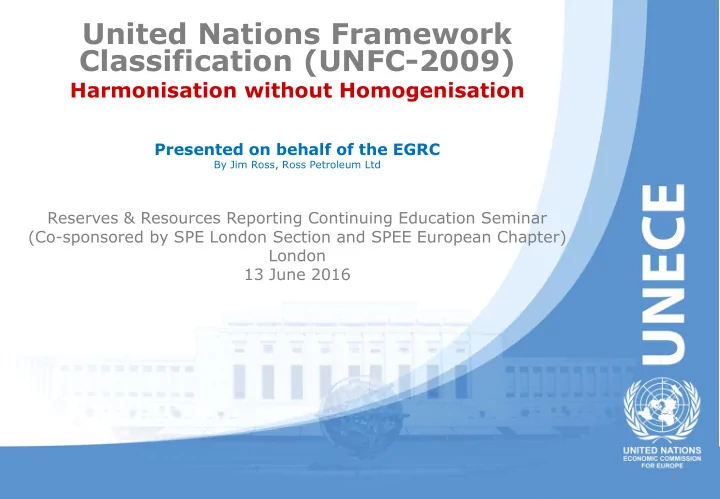

United Nations Framework Classification (UNFC-2009) Harmonisation without Homogenisation Presented on behalf of the EGRC By Jim Ross, Ross Petroleum Ltd Reserves & Resources Reporting Continuing Education Seminar (Co-sponsored by SPE London Section and SPEE European Chapter) London 13 June 2016 1
UNFC-2009 1. What is it? 2. How it works 3. Specifications 4. Summary 2
UNFC-2009 United Nations Framework Classification for Energy and Mineral Reserves and Resources Generic, principles-based system Applicable to both solid minerals and fluids – in fact to most commodities ‒ Based on three criteria ‒ E conomic and social viability ‒ F easibility and project status ‒ G eological knowledge and potential recoverability 3
Why three criteria? Proved reserves must be … Economic to extract Geologically well defined (commercially feasible) (with high confidence) Technically feasible to extract 4
UNFC-2009 1. What is it? 2. How it works 3. Specifications 4. Summary 5
UNFC – How it works Numerical coding system based on three criteria: E conomic and F easibility and G eological knowledge and potential recoverability social viability project status G1 F1 E1 G2 F2 E2 G3 F3 E3 G4 F4 6
UNFC – How it works E axis categories G axis F axis categories categories 7
E axis category definitions Category Definition E1 Extraction and sale has been confirmed to be economically viable. E2 Extraction and sale is expected to become economically viable in the foreseeable future. E3 Extraction and sale is not expected to become economically viable in the foreseeable future or evaluation is at too early a stage to determine economic viability. 8
UNFC – How it works • The category definitions are the building blocks of the system • These are combined (E, F, G) in the form of classes • Class 111 means that the reported quantities have satisfied the definitions for: – E1, F1 and G1 • There are no constraints on combinations, but not all will be meaningful 9
UNFC – How it works UNFC Class: 111 Category Definition E1 Extraction and sale has been confirmed to be economically viable. Category Definition F1 Feasibility of extraction by a defined development project or mining operation has been confirmed. Proved Reserves are those quantities of petroleum, Category Definition which by analysis of geoscience and engineering G1 Quantities associated data, can be estimated with reasonable certainty with a known deposit that to be commercially recoverable, from a given date can be estimated with a forward, from known reservoirs and under defined high level of confidence. economic conditions, operating methods, and 10 government regulations.
UNFC – Examples of classes 11
UNFC – 2D representation Sales Production Extracted Non-sales Production “Minimum” Categories Total commodity initially in place Class E F G Future recovery by commercial Commercial development projects or mining 1 1 1, 2, 3 Projects operations Potentially Commercial 2 2 1, 2, 3 Potential future recovery by Projects contingent development projects Non-Commercial or mining operations 3 2 1, 2, 3 Projects Additional quantities in place associated with known deposits 3 4 1, 2, 3 Potential future recovery by Exploration 3 3 4 successful exploration activities Projects 3 4 4 Additional quantities in place associated with potential deposits Each class is uniquely defined by its code 12
UNFC-2009 1. What is it? 2. How it works 3. Specifications 4. Summary 13
What are specifications? Classification Definitions Framework Application Specifications Rules Non- Guidelines Mandatory Guidance 14
Generic specifications 20 generic specifications, covering: Mandatory disclosure issues Project maturity Distinction between categories Aggregation General obligations Optional additional sub-categories and labels Extracted quantities that may be saleable in the future 15
Alignment of systems (schematic) UNFC-2009 PRMS CRIRSCO Sales Production Production Extracted Non-sales Production Total commodity initially in place Class Class Class Commercial Reserves Mineral Reserves Projects Potentially Commercial Mineral Resources Projects Contingent Resources Non-Commercial Not reported Projects Additional quantities in place Unrecoverable Not reported Exploration Exploration Prospective Resources Projects Results Additional quantities in place Unrecoverable Not reported 16
UNECE & SPE Partnership Memorandum of Understanding - 2006 The UNECE and SPE are working in partnership on the development of the UNFC and the PRMS. The SPE gains significant value from its work with the UNECE, including country access, introduction to new experts and access to ideas from other commodity groups applying the UNFC. 17
UNFC Classification Framework and Category Definitions Generic Specifications Bridging Bridging Bridging Document Document Document Petroleum Solid Mineral Specifications Specifications PRMS CRIRSCO Other Aligned Systems 18
UNFC Classification Framework and Category Definitions Generic Specifications Bridging Generic Renewable Document Energy Specifications Petroleum Commodity-specific Specifications Specifications: PRMS Geothermal Bioenergy Wind/solar/hydro 19
UNFC-2009 1. What is it? 2. How it works 3. Specifications 4. Summary 20
In summary … UNFC-2009 is a generic, principles-based system Applicable to both solid minerals and fluids ‒ Uses a numerical coding system ‒ Based on three criteria Economic and social viability ‒ Feasibility and project status ‒ Geological knowledge and potential recoverability ‒ Direct linkage to PRMS, CRIRSCO Template and NEA/IAEA Red Book Quantities can be estimated using these systems and reported – using the UNFC numerical codes Bridging documents under development for Russian Federation – and Chinese classification systems 21
In summary … Key goal is to provide a tool to facilitate global communications Generic specifications for renewable energy sources and injection – projects ready for final endorsement Specifications for geothermal energy almost completed, bioenergy – underway, wind/solar/hydro to follow UNFC-2009 has been formally selected as the resource – classification system of the System of Environmental-Economic Accounting 2012 Central Framework (SEEA-12), which has been adopted as an international standard by the United Nations Statistical Commission The Organisation for Economic Co-operation and Development – (OECD) is currently implementing SEEA-12 22
For more information on UNFC and the Expert Group • www.unece.org/energy/se/reserves.html • E-mail: reserves.energy@unece.org charlotte.griffiths@unece.org • Eighth EGRC Meeting, Geneva, • 25 - 28 April 2017 • UNFC Workshop on 25 April 2017 23
Recommend
More recommend